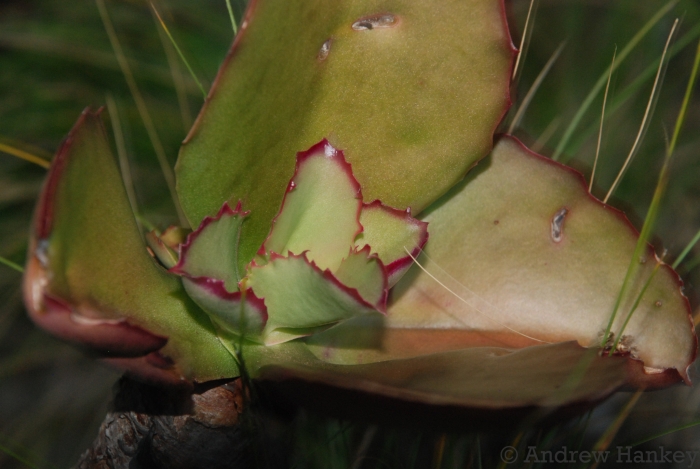Walking Kalanchoe
(Kalanchoe synsepala)
Walking Kalanchoe (Kalanchoe synsepala)
/
/

© Andrew Hankey
CC BY-SA 4.0
Image By:
© Andrew Hankey
Recorded By:
Copyright:
CC BY-SA 4.0
Copyright Notice:
Photo by: © Andrew Hankey | License Type: CC BY-SA 4.0 | License URL: http://creativecommons.org/licenses/by-sa/4.0/ | Uploader: andrew_hankey | Publisher: iNaturalist |














Estimated Native Range
Summary
Kalanchoe synsepala, commonly known as Walking Kalanchoe, is a perennial succulent plant native to the rocky outcrops and sandstone hills of Madagascar. It typically grows to a height of 12-18 inches (30-45 cm) with a similar spread. The plant is characterized by its broad, scalloped, fleshy leaves that are green with a reddish tinge on the margins. The tall flower stalk, which can reach up to 20 inches (50 cm), bears clusters of pendulous, bell-shaped flowers that range in color from white to pink, typically blooming in late winter to early spring. The flowers are modestly showy and add to the plant’s ornamental value.
Walking Kalanchoe is valued for its unique appearance and ease of care, making it a popular choice for rock gardens, container plantings, and as an indoor houseplant. It thrives in well-draining soil, requires minimal water once established, and prefers bright light with some protection from intense afternoon sun. Overwatering and poor drainage are common issues that can lead to root rot. It is also known for its ability to produce plantlets at the tips of the leaves, which can drop off and root, giving rise to its common name. This feature can be both a benefit for easy propagation and a potential problem if the plantlets spread uncontrollably.CC BY-SA 4.0
Walking Kalanchoe is valued for its unique appearance and ease of care, making it a popular choice for rock gardens, container plantings, and as an indoor houseplant. It thrives in well-draining soil, requires minimal water once established, and prefers bright light with some protection from intense afternoon sun. Overwatering and poor drainage are common issues that can lead to root rot. It is also known for its ability to produce plantlets at the tips of the leaves, which can drop off and root, giving rise to its common name. This feature can be both a benefit for easy propagation and a potential problem if the plantlets spread uncontrollably.CC BY-SA 4.0
Plant Description
- Plant Type: Succulent
- Height: 1-2 feet
- Width: 1-2 feet
- Growth Rate: Moderate
- Flower Color: Pink, White
- Flowering Season: Winter
- Leaf Retention: Evergreen
Growth Requirements
- Sun: Full Sun, Part Shade
- Water: Low
- Drainage: Fast
Common Uses
Drought Tolerant, Groundcover, Low Maintenance, Potted Plant
Natural Habitat
Rocky outcrops and sandstone hills of Madagascar
Other Names
Common Names: Cup Kalanchoe
Scientific Names: Kalanchoe synsepala , Kalanchoe brachycalyx , Kalanchoe gentyi , Kalanchoe trichantha
GBIF Accepted Name: